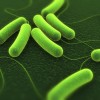Abstract
Escherichia coli is a bacterium found in the digestive system of healthy humans and animals and transmitted through fecal contamination. There are hundreds of known E. coli strains, with E. coli O157:H7 being the most recognized. This enterohemorrhagic E. coli (or EHEC) strain is responsible for an estimated 63,153 cases of infection and 20 deaths in the United States annually and causes approximately $255 million in losses each year. E. coli are found everywhere in the environment but mostly occupy animal surfaces and digestive systems, making it important to thoroughly wash anything that comes into contact with these surfaces. This 5-page fact sheet was written by Keith R. Schneider, Renée Goodrich Schneider, Alexandra Chang, and Susanna Richardson and published by the UF Department of Food Science and Human Nutrition, October 2013.
References
G. L. Armstrong, J. Hollingsworth, and J. G. Morris, Jr., "Emerging Foodborne Pathogens: Escherichia coli O157:H7 as a Model of Entry of a New Pathogen into the Food Supply of the Developed World," Epidemiologic Reviews 18, no. 1 (1996): 29-51. https://doi.org/10.1093/oxfordjournals.epirev.a017914
T. E. Besser, B. L. Richards, D. H. Rice, and D. D. Hancock, "Escherichia coli O157:H7 Infection of Calves: Infectious Dose and Direct Contact Transmission," Epidemiology and Infection 127 (2001): 555-560. https://doi.org/10.1017/S095026880100615X
Centers for Disease Control and Prevention, "E. coli (Escherichia coli)," National Center for Emerging and Zoonotic Infectious Diseases, Division of Foodborne, Waterborne, and Environmental Diseases, last modified January 4, 2013, http://www.cdc.gov/ecoli/.
C. L. Fischer Walker, J. A. Applegate, and R. E. Black, "Haemolytic-Uraemic Syndrome as a Sequela of Diarrhoeal Disease," Journal of Health, Population and Nutrition 30, no. 3 (2012): 257-261. https://doi.org/10.3329/jhpn.v30i3.12288
Food and Drug Administration, Code of Federal Regulations Title 21-Part 110. (Silver Spring, MD: Department of Health and Human Services, 2012), http://www.accessdata.fda.gov/scripts/cdrh/cfdocs/cfcfr/CFRSearch.cfm?CFRPart=110&showFR=1.
Food and Drug Administration. FDA 2009 Food Code - Table of Contents. [Online], 2009. http://www.fda.gov/Food/GuidanceRegulation/RetailFoodProtection/FoodCode/UCM2019396.htm.
S. Hoffmann, M. B. Batz, and J. G. Morris, Jr., "Annual Cost of Illness and Quality-Adjusted Life Year Losses in the United States due to 14 Foodborne Pathogens," Journal of Food Protection 75, no. 7 (2012): 1292-1302.
https://doi.org/10.4315/0362-028X.JFP-11-417
H. D. Kassenborg, C. W. Hedberg, M. Hoekstra, M. C. Evans, A. E. Chin, R. Marcus, D. J. Vugia, K. Smith, S. D. Ahuja, L. Slutsker, and P. M Griffin, for the Emerging Infections Programs FoodNet Working Group, "Farm Visits and Undercooked Hamburgers as Major Risk Factors for Sporadic Escherichia coli O157:H7 Infection: Data from a Case-Control Study in 5 FoodNet Sites," Clinical Infectious Diseases 38, Suppl. 3 (2004): S271-278. https://doi.org/10.1086/381596
W. E. Keene, J. M. McAnulty, F. C. Hoesly, L. P. Williams, Jr., K. Hedberg, G. L. Oxman, T. J. Barrett, M. A. Pfaller, and D. W. Fleming. "A Swimming-Associated
Outbreak of Hemorrhagic Colitis Caused by Escherichia Coli O157:H7 and Shigella Sonnei," The New England Journal of Medicine 331, no. 9 (1994): 579-584. https://doi.org/10.1056/NEJM199409013310904
E. C. Mathusa, Y. Chen, E. Enache, and L. Hontz. "NonO157 Shiga Toxin-Producing Escherichia coli in Foods," Journal of Food Protection 73, no. 9 (2010): 1721-1736. https://doi.org/10.4315/0362-028X-73.9.1721
P. R. Murray, E. J. Baron, J. H. Jorgensen, M. L. Landry, and M. A. Pfaller (Eds.), Manual of Clinical Microbiology, 9th ed. (Washington: ASM Press, 2007).
J. C. Paton, and A. W. Paton. "Pathogenesis and Diagnosis of Shiga Toxin-Producing Escherichia coli Infections," Clinical Microbiology Reviews 11, no. 3 (1998): 450-479. https://doi.org/10.1128/CMR.11.3.450
P. I. Tarr, "Escherichia coli O157:H7: Clinical, Diagnostic, and Epidemiological Aspects of Human Infection," Clinical Infectious Diseases 20, no. 1 (1995): 1-8. https://doi.org/10.1093/clinids/20.1.1
J. Tilden, Jr., A. McNamara, C. Custer, B. Boesel, M. A. Lambert-Fair, J. Majkowski, D. Vugia, S. B. Werner, J. Hollingsworth, and J. G. Morris, Jr., "A New Route of Transmission for Escherichia coli: Infection from Dry Fermented Salami," American Journal of Public Health 86, no. 8 (1996): 1142-1145. https://doi.org/10.2105/AJPH.86.8_Pt_1.1142
J. Tuttle, T. Gomez, M. P. Doyle, J. G. Wells, T. Zhao, R. V. Tauxe, and P. M. Griffin, "Lessons from a Large Outbreak of Escherichia coli O157:H7 Infections: Insights into the Infectious Dose and Method of Widespread Contamination of Hamburger Patties." Epidemiology and Infection 122 (1999): 185-192. https://doi.org/10.1017/S0950268898001976
Unless otherwise specified, articles published in the EDIS journal after January 1, 2024 are licensed under a Creative Commons Attribution-NonCommercial-NoDerivs 4.0 International (CC BY-NC-ND 4.0) license.


